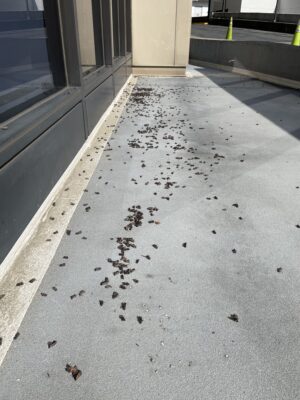While we eagerly anticipate the arrival of the resplendent autumn foliage, there has already been an arrival of a different kind – the invasion of the red-winged spotted lanternfly, to accompany mice, stink bugs and other overwintering pests.

With just a few simple preventive measures, you can take control of most pest situations, which can otherwise quickly spiral out of control. With more than 50 years in the pest control business at JP McHale Pest Management, I have some handy tips to help you avoid dreaded infestations.
The spotted lanternfly, the season’s most worrisome pest
The invasive spotted lanternfly is wreaking havoc throughout New York state, particularly in places like White Plains, with no signs of stopping. Although harmless to humans and pets, spotted lanterflies can cause widespread economic damage by destroying plants, trees and grapevines. The adults, recognizable by their stunning set of bright red wings, will stay active through November, laying their eggs, which is why it’s important to be especially vigilant now. The United States Department of Agriculture is asking everyone to kill spotted lanternflies on sight.
What to do if you see them:
- Squish them immediately to prevent repopulation.
- Scrape the egg masses and seal them in a plastic bag.
- Remove trees of heaven (ailanthus altissima) as spotted lanternflies lay their eggs on these invasive trees. Removing them from your property can help reduce the insects’ breeding grounds.
- Bring in the professionals: JP McHale has just launched a special spotted lanternfly treatment that features neem oil, an all-natural pesticide that kills both the nymph and adult lanternflies, and other topical oils that target the trunk/branches of trees in order to address the problem where it originates. This is then combined with a special soil treatment designed to combat spotted lanternflies at the “source of their destruction.”
- Report any sightings to your state department of agriculture.
A mouse in the house
Mice are notorious for finding their way into our homes when the temperatures drop. To prevent a mouse invasion, follow these steps:
- Seal entry points: Inspect your home for any cracks or gaps, especially around doors, windows, pipes and especially under the kitchen sink. Remember a mouse can fit through a hole the size of a dime.
- Store food securely: Keep food items in airtight containers, and don’t leave crumbs or open food packages lying around. Mice are excellent foragers.
- Regular cleaning: Maintain a clean home by regularly sweeping, vacuuming and sanitizing. Mice are less likely to visit a clean home.
- Be SMART: JP McHale’s SMART Cutting-Edge Technology detects rodent activity before you even see one mouse. It features 24/7 rodent monitoring and sends out rodent activity alerts, even without WiFi.

Stink bugs and other overwintering pests
Have you ever had a stink bug just drop onto your head and into your hair? Stink bugs make their entrances at some of the most unexpected times and in the most unexpected and inappropriate places. These annoying bugs and other overwintering pests (like leaf-footed plant bugs, ladybird beetles and cluster flies) seek shelter indoors as the temperature drops. Here’s how to keep them out of your home:
- Clean your gutters: Pests feed and make homes in built-up debris.
- Turn down the lights: Cluster flies and stink bugs are known to gather near light sources, so at night keep your blinds closed to avoid attracting these pests.
- Install screens: Use window screens to keep overwintering pests out while still allowing ventilation.
- Seal up any openings: Overwintering pests will find a way to enter your home through cracks and crevices around the foundation, siding, doors, windows, electrical wiring and plumbing. They will reside in walls where there is the most sun, so focus on those portions of your home that collect the most sun.
- Bring in the professionals: JP McHale’s Overwintering Treatments have been developed to interrupt the breeding cycle, so the treatments need to be completed before the first frost in order to reduce the level of activity throughout the season. The treatments are applied to the harboring shrubs and plants, windowsills, undersiding, eaves and chimneys, using environmentally sound products to discourage stink bugs and other invaders from coming inside as the weather gets colder.
- Mark your calendar: The most significant period of vulnerability for overwintering invaders is through November, which is why treatments must be done in the fall to be effective.
Wishing you a beautiful, happy and pest-free fall season.
Jim McHale is a Cornell entomologist and president and CEO of JP McHale Pest Management. For more, call 800-479-2284 or visit https://nopests.com.




















